
The Honey Creek valley looking southwest; over the ridge in the background is the Llano River. In the foreground archeologists can be seen under the clump of oak trees growing out of a small burned rock midden. TARL archives. |
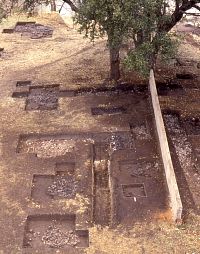
Bird's eye view looking south across the Honey Creek excavations. The concrete wall was part of a former goat shed the rancher had purposefully placed atop the well-drained rise created by the burned rock midden. The midden is hard to make out in this photo, but it runs under the wall and the oak trees are near its center. The individual clusters of rocks on the left are the remains of plant-baking facilities known as earth ovens. Notice that some clusters are dark colored while others are lighter? The dark ones are younger - only 800 years old (Late Prehistoric) while the light ones are Archaic features dating thousands of years ago. Prehistoric peoples knew a good spot when they found one. TARL archives. |

This is how the upper surface of most of the Honey Creek midden looked as it was exposed. Not much to see but small fire-cracked or "burned" rocks and dark carbon-stained soil. That and many roots from the oat trees that seemed to thrive growing into the organic-rich midden. TARL archives. |
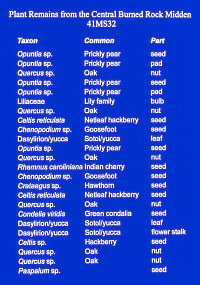
An amazing variety of charred plant remains were recovered from soil "matrix" samples collected from the Honey Creek midden. Archeobotanist Phil Dering processed the samples and identified the small charred fragments by making microscopic comparisons with modern samples at Texas A&M University. |
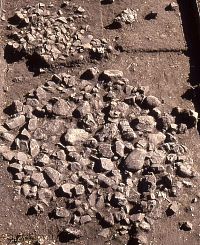
Circular "hearth" and small associated "scatter" (Features 7 and 8) uncovered just outside the midden at the Honey Creek site. Soil matrix samples collected from between the rocks yielded charred plants including acorns, sotol leaf bases, grass seeds, and several kinds of firewood. Radiocarbon dates suggest these features represent a very late event that occurred as late as the first decades after Europeans had entered the region (calibrated midpoints, A.D. 1580-1655). The absence of any European trade goods such as glass beads or metal tools, suggests that the site was probably occupied in latest prehistoric times. |

Recycled Point. Take a close look at this battered Martindale dart point from the Honey Creek site (click to enlarge). The white speckled area near the center is patinated, meaning that this surface has weathered and aged. In contrast, the edges of the blade or upper part of the dart point lack patina and are fresh looking. Notice also the inward curve segment on the irregular right-hand edge. Now turn to the "Prehistoric Recycling" section of the text and read an interpretation based on these details. TARL archives. |
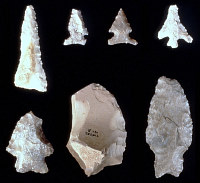
Selected artifacts from Cluster 6, a hodge-podge mix of arrow points, a few dart points, and other stone tools, several of which show evidence of recycling. Top row, left to right: triangular arrow point preform (unfinished manufacturing reject), fire-damaged Edwards arrow point, pristine Edwards arrow point, and a untyped arrow point. Bottom row, left to right: recycled Martindale dart point, recycled biface fragment, recycled Pedernales dart point. TARL archives. |

Cover of the 1997 study reporting the work at the Honey Creek site and three other sites across the "greater" Edwards Plateau. This two-volume study earned the authors the Texas Historical Commission's 1998 Award of Excellence in Archeology. |
|
The investigation of a rather ordinary
prehistoric campsite overlooking a small tributary
of the Llano River in western Mason County gave archeologists
much insight into hot rock cooking, the process
that left its permanent mark at tens of thousands of localities across
the Plateaus and Canyonlands region. The most obvious “marks” left
by hot rock cooking are the two most common archeological features—burned rock middens and hearths. Middens are large mounded accumulations of fire-cracked cooking
rocks and other debris generated by earth oven facilities used over
and over to bake plants. "Hearths" are relatively small circular
patterns of cooking rocks that represent individual cooking
episodes quite similar to those that resulted in the midden
accumulation.
What makes the Honey Creek site (41MS32) extraordinary is
not the nature of the site itself, but what was learned from
it. The site was excavated in 1987-1988 by an archeological
team from the Texas Department of Transportation led by Glenn T. Goode,
prior to its destruction by a road widening project. A few
years later, a research team from the Texas Archeological Research
Laboratory (TARL, UT Austin) led by Steve Black analyzed the field results as
part of a larger study of four similar “burned rock midden” sites. The Honey Creek site proved
especially informative because both the field and the lab teams
asked timely questions and were able to marshall the data needed to answer most of their
questions.
Hot Rock Cooking at Honey Creek
In the late 1980s, researchers were beginning to understand
how and why burned rock middens formed, but they hadn’t
quite put the pieces together. A sketch of the history of
midden interpretation can be found in the Camp
Bowie exhibit.
The analysis of the Honey Creek site helped pull research
threads together because the site had yielded the “right stuff”—well-preserved, charred plant remains, good field documentation,
and really good dirt—dozens of soil samples collected
from within the midden and from individual oven features.
What archeologists classify as "burned rock midden sites"
are open campsites containing one or
more middens and various other features such as hearths.
In other words, middens are special site features, not sites in and
of themselves. At the Honey Creek site there was only one
small midden about 45 feet in diameter (13-x-15 meters)
and less than two feet thick. Because the field archeologists
carefully weighed samples of the burned rocks making up the
midden, the total mass could be calculated –12.5 metric
tons or so (about 27,600 pounds). And this is just a
small midden. At some sites in the region, individual middens
cover several acres and must have a mass of well over
a hundred metric tons.
What caused native peoples to amass all these fire-cracked
rocks in one place? Plant baking. They baked plants with
heated limestone rocks in layered cooking arrangements known
as earth ovens. You can read more about earth ovens elsewhere in
this website, but consider a few telling numbers from the
midden at the Honey Creek site. We can calculate, at least
crudely, the number of plant baking episodes it took to form
this smallish midden. Based on field data and experimental
work, an average-size individual earth oven required the
use of roughly 500 lbs of cooking rocks. Dividing this into
the total midden mass (27,600 lbs), we get 52 ovens. But,
experimental work shows that a good cooking rock could
be used about three times before it cracked into pieces too
small to be reused. So, multiple 52 by 3 and we arrive at
a projection of 156 ovens. To recap, the total mass of the
small midden at the Honey Creek site is estimated to represent
the accumulated debris resulting from perhaps 156 oven-baking
episodes. But what was being cooked in the ovens?
We can answer that question because Goode carefully collected
10-liter soil matrix samples from 16 individual hearth/oven
features as well as samples from various areas within the
midden. During the analysis phase, archeobotantist Phil Dering,
an archeologist and botanist then at Texas A&M University, “floated” each
matrix sample. This means he used a water flotation processing
technique to skim off the “light fraction” charred
plant remains for identification—the charred bits float,
rocks and bones sink. Once the light fraction samples dried,
Dering spent many hours identifying the genus, and species
of plants represented by the small charred fragments. He did this by comparing
the archeological specimens to “known” samples
of charred modern plants collected especially for comparative study.
Check out the accompanying summary list of the identified
plant remains found in the Honey Creek midden. This is a fascinating assortment of plants and includesonly the potentially edible plants. At least 14
different kinds of charred wood were also recovered from
the midden—oak wood (live oak and red oak) was the
most common, followed by persimmon, hackberry, walnut, juniper, buckthorne, and others. It looks like the Honey Creek cooks burned
any dry wood their children could lay their hands on. (In
hunting and gathering societies, everyone pitched in and
the task of fetching firewood usually fell to children.)
And there were no log fragments, all of the firewood appears
to have been harvested as stick-sized chunks—dead
limbs and twigs that could be easily broken off and hauled
back to camp.
The edible parts—seeds, nuts, stalks, bulbs, hearts, leaves, or pads—of at least nine different plant species
were found in the midden. But most of the nuts and seeds
from plants such as Indian cherry, goosefoot, hackberry,
and oak don’t need to be baked. These (and various
animal bone fragments) are thought to represent ordinary
cooking debris from other kinds of cooking activities that took place
in the midden area. (Only plant baking requires lots of hot
rocks and here we are trying to explain why the heap of spent
cooking rocks formed.) Among the charred plants from the
Honey Creek midden, the most likely baking candidates are
prickly pear pads, sotol and perhaps yucca leave bases (hearts), and
the bulbs of lily family plants such as wild onions. Visit
the Plant Gallery in the Nature’s Harvest section for
details about how these plants were used.
The charred identified plant fragments were also used for
radiocarbon dating. The accompanying graph tells the dating
story. The Honey Creek midden formed over a 600-year time
span between about A.D. 1100-1700, during the Late Prehistoric
period and the very early historic era. Now let’s finish
the numbers.
As explained, the small midden at the Honey Creek site is
estimated to have formed from the accumulated debris generated
by perhaps 156 ovens (individual plant-baking episodes).
That sounds like a lot, but not when you factor in time—the
midden formed over a 600 year period. That means we could
account for the accumulation of spent cooking stones (i.e.,
the midden) if small bands of hunter-gatherers had stopped at the site merely
every 3.8 years and fired up only a single
oven each time.
Of course it must not have happened so regularly. More likely,
family bands of 15-20 people came to the Honey Creek site once every generation
or so and did quite a bit of baking for a few days or a week
or two. That would also help explain why additional
ovens were found outside the midden—the site may
have been a busy place during the peak availability of baking
plants. These site use episodes probably didn’t occur
very often simply because it wouldn’t take long for
an experienced family of gatherers to harvest all the nearby
mature sotol plants or dig out a thick nearby patch of wild
onions. Once heavily harvested, these plants take many
years to grow back into a dense stand. In other words, it
is likely that people came to the site to bake plants only
when the targeted plants in the immediate area were ripe
for the picking and that probably didn’t happen all
that often.
Such educated guesses are just that: educated guesses or
interpretations based on the facts as we archeologists know
them at the time and on as many lines of evidence as we can
bring together. It is our job to read between the lines of
evidence and put forth a solid argument and plausible interpretation.
As archeologists investigate more sites like the Honey Creek
site and ask the right questions, we will learn more and
come up with improved interpretations and better educated
guesses about what happened in the past. This is how archeology
as a science progresses: tiny charred bit by tiny charred
bit, date by date, and reasoned inference by reasoned inference.
The Honey Creek site in southwestern Mason County may have been
a rather ordinary archeological site, but it yielded some fascinating insight
into the prehistory of the Plateaus and Canyonlands.
Prehistoric Recycling: The Case of the Battered
Martindale
Take a look at the photo on the left labeled “Recycled
Point.” This Martindale dart point is of a style made in
late Early Archaic times, perhaps 7000-8000 years ago (5000-6000
B.C.). But it was found in the upper deposits at the Honey
Creek just north of the midden along with a hodge-podge mix
of arrow points, a few dart points, and other stone tools,
several of which show evidence of recycling
At first glance, this cluster of artifacts (Cluster 6 as shown on plan map
on the right) might be considered a “mixed-age” accumulation
of artifacts made thousands of years apart and too mixed
up to make any sense of. But close study reveals a different
story. The northern edge of the Honey Creek midden appears to be an area where stone tools were
made and used during the same period the midden formed (A.D.
1100-1700). The arrow points (most of which were broken as they were being made) date to that time. But the Martindale and several
other dart points appear to have been recycled tools, probably
reused on the spot by the later arrowhead-making peoples. Study
the enlarged photo of the recycled point, read the caption, and then come back
and read the following.
Here is what we think these details observed on the Martindale
point may mean. The original point was made, used for deer hunting,
and discarded at the end of its “use life” by
its original owner some 7000-8000 years ago. The point was
probably left behind after it was used and resharpened several
times, rendering it too short, stubby, and dull for a proper hunting point—most
dart points were discarded for similar reasons. For thousands
of years the Martindale point just lay there, slowly developing patina.
Much later, during the 600-year period the Honey
Creek midden was in use (A.D. 1100-1700), somebody spied
the Martindale point lying on the ground and picked it up. Or perhaps they found it while scraping up a basket of dirt to help seal an earth oven.
However it was found, somebody realized it could be used to make a simple cutting
or scraping tool. Grabbing a convenient
hammerstone, the person
quickly knocked off a few small chips (small flakes) from
the edge of the point to create a fresh, sharp edge. A sharp
edge would be useful for many everyday tasks, just like you
use a pocket knife or a pair of scissors. Daily task accomplished,
the recycled point was soon abandoned again.
Hundreds of years later, Glenn Goode spotted
this Martindale point during the excavations and socked it
away in a properly labeled bag. And a few years later, Steve
Black opened the bag and looked closely at this specimen and others from the
site and came up with this explanation. Such “just-so” stories
must be recognized for what they are and taken with a grain
of salt. We’ll never know the details of exactly what
happened 700 years ago. But the details don’t really
matter as much as understanding the pattern to answer the
question—why was a battered old dart point with freshly
chipped edges found amid much younger artifacts? We can be
confident that native peoples were practiced recyclers throughout
prehistoric times. This old, commonsense habit probably accounts
for considerable “mixing” of materials of different
ages in archeological deposits.
Teaching Honey Creek
What's
Cookin' at Honey Creek? introduces students to the fascinating
process in which prehistoric "chefs" on the Edwards Plateau cooked quantities
of plant bulbs in earth ovens by using hot rocks. This cooking technique was
used for more more than 8,000 years in Texas, so they clearly had a recipe
for success! View
TEKS and download page.
Credits & Sources
This exhibit was written by Steve Black, TBH co-editor and leader of the analysis
team at TARL that studied the excavation results from the
Honey Creek site on behalf of the Texas Department of Transportation. This exhibit was developed as part of the Prehistoric Texas project.
Print Sources
Black, Stephen L., and Alston V. Thoms
2014 Hunter-Gatherer Earth Ovens in the Archaeological Record: Fundamental Concepts. American Antiquity 79(2) pp. 203-226. Download article as PDF.
Black, Stephen L., Linda W. Ellis, Darrell G. Creel, and
Glenn T. Goode
1997 Hot Rock Cooking on the Greater Edwards Plateau:
Four Burned Rock Midden Sites in West Central Texas. Texas
Archeological Research Laboratory, Studies in Archeology
22, UT Austin. (Published jointly
with the Texas Department of Transportation.)
Black, Stephen L.
1997 "The Honey Creek Site, 41MS32." Chapter
6 in the above volume.
1997 "Oven Cookery at the Honey Creek Site." Chapter 10 in
the above volume.
Goode, Glenn T.
1991 Late Prehistoric Burned Rock Middens in Central Texas. In: Hester, Thomas R., ed., The Burned Rock Middens of Texas: An Archeologial Symposium. Studies in Archeology 13, Texas Archeological Research Laboratory, UT Austin.
|
|
|
|
In This Section:
|
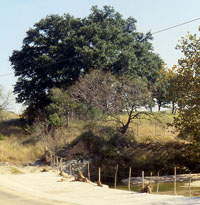
The Honey Creek site sits on a terrace overlooking the creek. The grove of live oak trees in this picture are growing out of the center of the site's small burned rock midden. Honey Creek drains the Llano Uplift, carrying granite sands down the creek. The site itself is just on the edge of the Llano Uplift where the normal limestone bedrock of the Edwards Plateau resumes. TARL archives. |
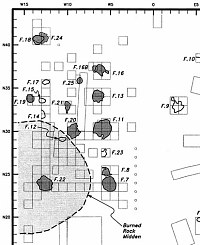
Map of the Honey Creek site showing the midden and the many individual "hearth" features as well as the excavation areas and the grid system (numbered tick marks around border). The shaded individual features such as Feature 22 (F.22) in the center of the midden are those judged to be in "primary" context, meaning these patterns represent the remains of intact cooking facilities (mainly the beds of earth ovens). The unshaded "secondary" features are clustered scatters of fire-cracked cooking rocks from dismantled or otherwise disturbed cooking features. Graphic by Dan Julien, from Black et al. 1997, Figure 37. |

This intact oven bed was found near the center of the Honey Creek midden. The concrete goat shed wall ran right over it, but did no harm. Notice the dark carbon-stained midden soil found in the central area of the midden. Oven after oven was built and rebuilt in this "black hole" at the center of the midden. Each oven episode involved cleaning out the debris leftover from the last one, pitching out the small fire-cracked rocks and recycling those still big enough to be useful. New cooking rocks were added as necessary and a roaring fire was built to heat the rocks. A wooden pole may have been used to form an even circular bed of hot rocks upon which layers of plant food and packing material were heaped, capped by a thick layer of earth to hold in the steamy heat. Two days later, the baked bulbs and roots were ready to eat. When the food was removed, the oven bed remained intact. So, the bed seen here is probably the remains of the last oven ever built in the Honey Creek midden. TARL archives. |

The Honey Creek midden formed over a 600-year period between about A.D. 1100-1700, during the Late Prehistoric period and perhaps even the very early historic era. This burned rock midden (BRM) is very well dated by a sequence of 14 radiocarbon assays (dates) including one predating the midden and one postdating it. Shown here are the distributions of the full probability ranges of each" date"- radiocarbon dating actually yields statistical estimates, not fixed dates. The inferred period of midden (BRM) is based on the overall probability patterns. This graphic shows why it takes more than one radiocarbon date to pin-down site use periods. From Black et al. 1997, Figure 62. |
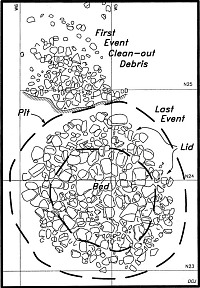
Plan drawing of Feature 7/8 showing the inferred functional parts of this earth oven facility. This "hearth" and "scatter" are thought to be the result of at least two oven use episodes. The "first event" is represented by a scattered patch of small fire-cracked rocks cleaned out of a cooking pit when the "last event" transpired. The last event is represented by a tightly packed bed of mainly intact cooking stones surrounded by a ring of smaller rocks thought to represent "lid" rocks-a second layer of heated rocks placed above the sotol hearts baked in this oven. If this sounds like a tenuous interpretation, it is, but it is one supported by multiple lines of evidence including the charred remains of firewood and sotol leaf bases. Graphic by Dan Julien, from Black et al. 1997: Figure 131. |
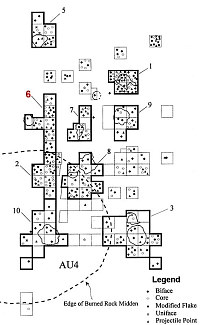
Plan map highlighting clusters of artifacts found in the Honey Creek excavations. These clusters are somewhat arbitrary groupings defined mainly by the limits of excavation. Nonetheless, some interesting patterns are present, as exemplified by Cluster 6. From Black et al. 1997, Figure 74. |
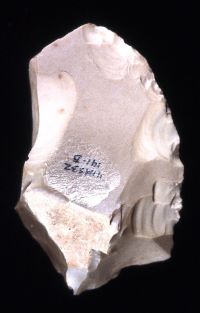
Close up of a recycled biface fragment. This biface was never finished and probably rejected because it had a thick spot marked by the triangular patch of cortex (outer surface) in the lower left. Abandoned, it aged and formed a dark patina - seen here as the dark gray-brown surface in the middle of the artifact. Much later in time, during the period the midden was in use, someone picked up the reject and found a new use for it. This is obvious because of the fresh flaking around the edge (the lighter colored areas). Such recycling was a common practice among the native peoples of the region, but one that archeologists have been slow to recognize. We now realize that artifacts sometimes had a long "use life" sometimes interrupted by thousands of years. Such messy facts can make archeological interpretation quite challenging. TARL archives. |
|